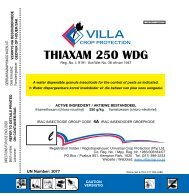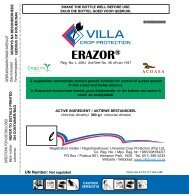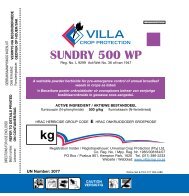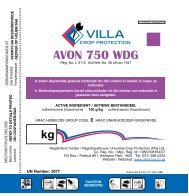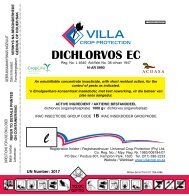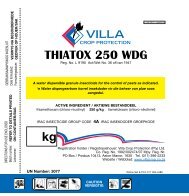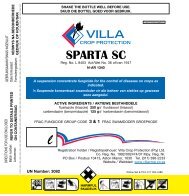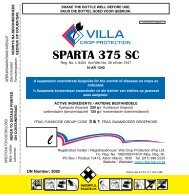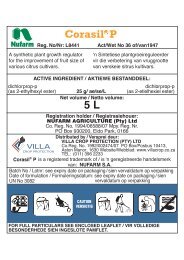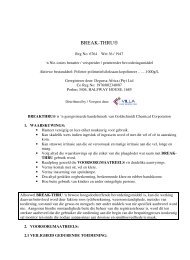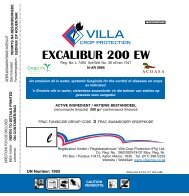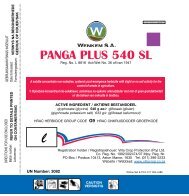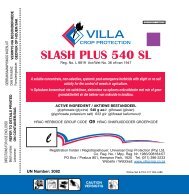universal carbaryl 850 wp material safety data sheet - Villa Crop ...
universal carbaryl 850 wp material safety data sheet - Villa Crop ...
universal carbaryl 850 wp material safety data sheet - Villa Crop ...
You also want an ePaper? Increase the reach of your titles
YUMPU automatically turns print PDFs into web optimized ePapers that Google loves.
UNIVERSAL <strong>Crop</strong> Protection (Pty) Ltd Subject: CARBARYL <strong>850</strong> WP<br />
Co. Reg. No.: 1983/008184/07 Document no: 100UM<br />
Effective Date: November 2004<br />
Revision no: June 2011 (3)<br />
Product Code: ICARBA<strong>850</strong>/DU<br />
UNIVERSAL CARBARYL <strong>850</strong> WP MATERIAL SAFETY DATA SHEET<br />
1. IDENTIFICATION OF THE SUBSTANCE<br />
Product name: CARBARYL <strong>850</strong>WP<br />
Insecticide<br />
UN No.: 2757<br />
Supplier: Universal <strong>Crop</strong> Protection (Pty) Ltd<br />
PO Box 801,<br />
Kempton Park, 1620, South Africa<br />
Telephone: (011) 396 2233<br />
Fax: (011) 396 4666<br />
Website: www.villacrop.co.za<br />
Emergency telephone: (011) 396 2233<br />
24 Hr Emergency Numbers:<br />
Bateleur Trauma: 083 1233 911<br />
(Client: <strong>Villa</strong> <strong>Crop</strong> Protection)<br />
Tygerberg Hospital: (021) 938 6084<br />
Red Cross Information Centre: (021) 689 5227<br />
Griffon Poison Information Centre: 082 446 8946<br />
2. COMPOSITION / INFORMATION ON INGREDIENTS<br />
Common name: Carbaryl<br />
Chemical Name: 1-naphthyl methylcarbamate<br />
(IUPAC)<br />
CAS No.: 63-25-2<br />
Chemical Family: Carbamate <strong>850</strong> g/kg<br />
Chemical Formula: C12H11NO2<br />
Molecular weight: 201.2<br />
Use: A wettable powder insecticide for certain<br />
agricultural, public health and household uses. A<br />
residual contact and stomach poison for the<br />
control of insect pests as listed on the label.<br />
Formulation: Wettable Powder<br />
Symbols: Xn, N<br />
Risk-phrase(s): R22<br />
3. HAZARD IDENTIFICATION<br />
Toxicity class: WHO II, EPA I<br />
ADI: 0.01 mg/kg b.w<br />
NOEL: 200 mg/kg (rats) - 2 year<br />
ACGIH: 5 mg/m 3 Carbaryl<br />
10 mg/m 3 Nuisance dust<br />
STEL: 15 mins 10 mg/m 3<br />
TWA: 8 hours 5 mg/m 3<br />
Main Hazard:<br />
Toxic to fish and bees. Carbaryl is a carbamate<br />
compound, which inhibits cholinesterase. It is toxic.<br />
Contact with skin, inhalation of dust or spray, or swallowing<br />
may be fatal.<br />
Fire and explosion hazard:<br />
Slight fire hazard when exposed to heat or flame. Dust-air<br />
mixtures may ignite or explode.<br />
Biological Hazard:<br />
Likely routes of exposure: May be absorbed from the<br />
gastrointestinal tract, through the intact skin, and through<br />
inhalation of fine spray mist or dust.<br />
Eye contact:<br />
Tests indicate the product is minimally toxic, however<br />
caution should be practiced when handling the product.<br />
The product was found to be non-irritating.<br />
Skin contact:<br />
Tests indicate the product is minimally toxic, however<br />
caution should be practiced when handling the product.<br />
The product was found to be non-irritating.<br />
Ingestion:<br />
Toxic by ingestion. See point 4 for symptoms.<br />
Inhalation:<br />
Toxic by inhalation. See point 4 for symptoms.<br />
4. FIRST AID MEASURES AND PRECAUTIONS<br />
Proper care should be taken during occupational use to<br />
avoid any inhalation of dust and spray particles, and to<br />
prevent accidental contamination of food products and<br />
water.<br />
The product is a Cholinesterase inhibitor.<br />
Inhalation:<br />
Acute exposure:<br />
When inhaled, the first effects of cholinesterase inhibition<br />
are usually respiratory and may include nasal hyperaemia<br />
and watery discharge, chest discomfort, dyspnea, and<br />
wheezing due to increased bronchial secretions and<br />
bronchoconstriction. Other systemic effects may begin<br />
within a few minutes or several hours of exposure.<br />
Symptoms may include nausea, vomiting, diarrhoea,<br />
abdominal cramps, headache, vertigo, ocular pain, ciliary<br />
muscle spasm, blurring or dimness of vision, miosis, or in<br />
some cases mydriasis, lacrimation, salivation, sweating,<br />
and confusion. Other reported central nervous system or<br />
neuromuscular effects include ataxia, slurred speech,<br />
weakness, fatigue, twitching, fasciculation, tremor, and<br />
eventually paralysis of the extremities and possibly of the<br />
respiratory muscles. In severe cases, there may also be<br />
involuntary defecation and urination, bradycardia,<br />
hypotension, pulmonary oedema, convulsions, coma, and<br />
death from respiratory failure or cardiac arrest. Carbaryl<br />
does not accumulate in mammalian tissue and the<br />
cholinesterase inhibition reverses rather rapidly. In nonfatal<br />
cases, the illness generally lasts less than 24 hours.<br />
Chronic exposure:<br />
Prolonged or repeated exposure may cause effects as<br />
described in acute exposure.<br />
Page 1 of 6
UNIVERSAL <strong>Crop</strong> Protection (Pty) Ltd Subject: CARBARYL <strong>850</strong>WP<br />
Co. Reg. No.: 1983/008184/07 Document no: 100UM<br />
Effective Date: November 2004<br />
Revision no: June 2011 (3)<br />
Product Code: ICARBA<strong>850</strong>/DU<br />
UNIVERSAL CARBARYL <strong>850</strong>WP MATERIAL SAFETY DATA SHEET<br />
First aid:<br />
Remove from exposure area to fresh air immediately. If<br />
breathing has stopped, give mechanical artificial<br />
respiration (not direct mouth-to-mouth). Maintain airway<br />
and blood pressure and administer oxygen if available.<br />
Keep affected person warm and at rest. Treat<br />
symptomatically and supportively. Qualified personnel<br />
should perform administration of oxygen. Get medical<br />
attention immediately.<br />
Skin contact :<br />
Acute exposure:<br />
Some compounds may cause irritation. Localized sweating<br />
and fasciculations may occur at the site of contact. If<br />
sufficient amounts are absorbed through the skin, other<br />
effects of cholinesterase inhibition may occur as described<br />
in acute inhalation. Symptoms may be delayed for 2-3<br />
hours, usually no more than 8 hours.<br />
Chronic exposure:<br />
Repeated or prolonged exposure may cause effects as<br />
described in acute exposure.<br />
First aid:<br />
Remove contaminated clothing immediately. Wash<br />
contaminated areas with soap and water followed by<br />
alcohol. Emergency personnel should wear gloves and<br />
avoid contamination. Treat respiratory difficulty with<br />
mechanical artificial respiration. Get medical attention<br />
immediately.<br />
Eye contact :<br />
Acute exposure:<br />
Direct contact may cause pain, hyperaemia, and<br />
lacrimation, twitching of the eyelids, miosis, and ciliary<br />
muscle spasm with loss of accommodation, blurred or<br />
dimmed vision and browache. Sometimes mydriasis may<br />
occur instead of miosis. With sufficient exposure, other<br />
symptoms of cholinesterase inhibition may occur as<br />
described in acute inhalation.<br />
Chronic exposure:<br />
Prolonged exposure may cause effects as described in<br />
acute exposure. Some compounds have caused toxic<br />
effects on the crystalline lens, conjunctival thickening and<br />
obstruction of nasolacrimal canals when used as miotic<br />
eye drops.<br />
First aid:<br />
Irrigate eyes with water or saline solution. If symptoms of<br />
poisoning occur, treat respiratory difficulty with mechanical<br />
artificial respiration and oxygen. Observe patient for at<br />
least 24-36 hours. Get medical attention immediately.<br />
Qualified medical personnel should administer oxygen.<br />
Ingestion:<br />
Acute exposure:<br />
When ingested, the first effects may be nausea, vomiting,<br />
anorexia, abdominal cramps, and diarrhoea. With<br />
absorption from the gastrointestinal tract, the other effects<br />
of cholinesterase inhibition as described in acute inhalation<br />
may occur. Symptoms may begin within minutes or be<br />
delayed several hours.<br />
Chronic exposure:<br />
Repeated ingestion may cause effects as described in<br />
acute exposure.<br />
First aid:<br />
If person is alert and respiration is not depressed, give<br />
syrup of Ipecac followed by water (if vomiting occurs, keep<br />
head below hips to prevent aspiration). If consciousness<br />
level declines or vomiting has not occurred in 15 minutes<br />
empty stomach by gastric lavage with the aid of cuffed<br />
endotracheal tube using isotonic saline or 5 %<br />
sodium bicarbonate follow with activated charcoal.<br />
Establish and maintain airway. Treat respiratory difficulty<br />
with artificial respiration and oxygen.<br />
Do not give morphine, aminophylline, phenothiazines,<br />
reserpine, furosemide, or ethacrynic acid. Drugs like 2<br />
PAM are not effective in poisoning with Carbaryl AND<br />
SHOULD NOT BE USED.<br />
Treat symptomatically and supportively. Qualified medical<br />
personnel must perform administration of oxygen and<br />
gastric lavage. Get medical attention immediately.<br />
Advice to physician:<br />
Antidote:<br />
The following antidote has been recommended. However,<br />
the decision as to whether the severity of poisoning<br />
requires administration of any antidote and actual<br />
dose required should be made by qualified medical<br />
personnel.<br />
For cholinesterase inhibitors: Establish clear airway and<br />
tissue oxygenation by aspiration of secretions, and if<br />
necessary, by assisted pulmonary ventilation with oxygen.<br />
Improve tissue oxygenation as much as possible before<br />
administrating atropine to minimise the risk of ventricular<br />
fibrillation. Administer atropine sulphate intravenously, or<br />
intramuscularly if iv injection is not possible. In moderately<br />
severe poisoning administer atropine sulphate, 0.4-2.0 mg<br />
repeated every 15 minutes, until atropinization is achieved<br />
(tachycardia, flushing, dry mouth, mydriasis). Maintain<br />
atropinization by repeated doses for 2-12 hours, or longer,<br />
depending on the severity of poisoning. The appearance<br />
of rales in the lung bases, miosis, salivation, nausea,<br />
bradycardia, are all indications of inadequate<br />
atropinization. Severely poisoned individuals may exhibit<br />
remarkable tolerance to atropine. Two or more times the<br />
dosages suggested above may be needed. Persons not<br />
poisoned or only slightly poisoned, however, may develop<br />
signs of atropine toxicity from such large dosages: fever,<br />
muscle fibrillations, and delirium are main signs of atropine<br />
toxicity. If these signs appear while the patient is fully<br />
atropinized, atropine administration should be<br />
discontinued, at least temporarily. Observe treated patients<br />
Page 2 of 6
UNIVERSAL <strong>Crop</strong> Protection (Pty) Ltd Subject: CARBARYL <strong>850</strong>WP<br />
Co. Reg. No.: 1983/008184/07 Document no: 100UM<br />
Effective Date: November 2004<br />
Revision no: June 2011 (3)<br />
Product Code: ICARBA<strong>850</strong>/DU<br />
UNIVERSAL CARBARYL <strong>850</strong>WP MATERIAL SAFETY DATA SHEET<br />
closely at least 24 hours to ensure that symptoms<br />
(possibly pulmonary oedema) do not recur as<br />
atropinization wears off. In very severe poisonings,<br />
metabolic disposition of toxicant may require several hours<br />
or days during which atropinization must be maintained.<br />
Markedly lower levels of urinary metabolites indicate that<br />
atropine dosage can be tapered off. As dosage is reduced,<br />
check the lung bases frequently for rales. If rales are<br />
heard or other symptoms return, re-establish atropinization<br />
promptly.<br />
5. FIRE FIGHTING MEASURES<br />
Fire and explosion hazard:<br />
Slight fire hazard when exposed to heat or flame. Dust-air<br />
mixtures may ignite or explode.<br />
Extinguishing agents:<br />
Extinguish small fires with carbon dioxide, dry powder,<br />
Halon, water spray, or alcohol-resistant foam. Water spray<br />
can be used for cooling of unaffected stock, but avoid<br />
water coming in contact with the product. Contain water<br />
used for firefighting for later disposal<br />
Firefighting:<br />
Move containers from fire area if possible. Fight fire from<br />
maximum distance. Stay away from storage tank ends.<br />
Contain fire control water for later disposal. Do not scatter<br />
<strong>material</strong>, extinguish only if flow can be stopped. Use<br />
flooding amounts of water as a fog as solid streams may<br />
be ineffective. Cool containers with flooding amounts of<br />
water as far a distance as possible. Use water spray to<br />
absorb toxic vapours. Avoid breathing toxic vapours.<br />
Keep upwind. Consider evacuation of downwind area if<br />
<strong>material</strong> is leaking.<br />
Special Hazards:<br />
Fire may produce irritating or poisonous vapours<br />
(sulphoxides), mists or other products of combustion.<br />
Personal protective equipment:<br />
Carbaryl dust may be transported in the smoke from a<br />
fire. Fire fighters and others that may be exposed should<br />
wear full protective clothing and self-contained breathing<br />
apparatus.<br />
6. ACCIDENTAL RELEASE MEASURES<br />
Personal precautions:<br />
Avoid contact with skin and eyes. Do not breathe in dust<br />
or fumes. For personal protection see Section 8.<br />
Environmental precautions:<br />
Do not allow entering drains or watercourses. When the<br />
product contaminates public waters, inform appropriate<br />
authorities immediately in accordance with local<br />
regulations.<br />
Occupational spill:<br />
Do not touch spilled <strong>material</strong>. Stop leak if you can do so<br />
without risk. Use water spray to reduce vapours (contain<br />
any water used). For small spills, sweep up with sand or<br />
other suitable absorbent <strong>material</strong>, such as sawdust, and<br />
place into containers for later disposal. Move containers<br />
from spill area. For larger spills, contain <strong>material</strong> far<br />
ahead of spill for later disposal. Keep spectators away.<br />
Isolate hazard area and deny entry. Ventilate closed<br />
spaces before entering.<br />
7. HANDLING AND STORAGE REQUIREMENTS<br />
Handling:<br />
Toxic by inhalation or if swallowed. Avoid contact with<br />
eyes, prolonged contact with skin, and inhalation of dust<br />
and vapour. Use with adequate ventilation. Wash hands<br />
before eating, drinking, chewing gum, smoking, or using<br />
the toilet. Remove clothing immediately if this product gets<br />
inside. Then wash skin thoroughly using a non-abrasive<br />
soap and put on clean clothing. Do not apply directly to<br />
areas where surface water is present, or to intertidal areas<br />
below the mean high water mark. Water used to clean<br />
equipment must be disposed of correctly to avoid<br />
contamination.<br />
Storage:<br />
The product must be kept under lock and key. Keep out of<br />
reach of unauthorized persons, children and animals.<br />
Store in its original labeled container in shaded, wellventilated<br />
area, away from heat, sparks and other sources<br />
of ignition. Not to be stored next to foodstuffs and water<br />
supplies. Local regulations should be complied with.<br />
8. EXPOSURE CONTROL / PERSONAL PROTECTION<br />
Occupational exposure limits:<br />
No occupational limits established by OSHA, ACGIH or<br />
NIOSH<br />
Engineering control measures:<br />
It is essential to provide adequate ventilation. The<br />
measures appropriate for a particular worksite depend on<br />
how this <strong>material</strong> is used and on the extent of exposure.<br />
Ensure that control systems are properly designed and<br />
maintained. Comply with occupational <strong>safety</strong>,<br />
environmental, fire, and other applicable regulations.<br />
PERSONAL PROTECTIVE EQUIPMENT:<br />
If engineering controls and work practices are not effective<br />
in controlling exposure to this <strong>material</strong>, then wear suitable<br />
personal protective equipment including approved<br />
respiratory protection.<br />
Respirator:<br />
Page 3 of 6
UNIVERSAL <strong>Crop</strong> Protection (Pty) Ltd Subject: CARBARYL <strong>850</strong>WP<br />
Co. Reg. No.: 1983/008184/07 Document no: 100UM<br />
Effective Date: November 2004<br />
Revision no: June 2011 (3)<br />
Product Code: ICARBA<strong>850</strong>/DU<br />
UNIVERSAL CARBARYL <strong>850</strong>WP MATERIAL SAFETY DATA SHEET<br />
An approved respirator suitable for protection from dusts<br />
and mists of pesticides is adequate. Limitations of<br />
respirator use specified by the approving agency and the<br />
manufacturer must be observed.<br />
Clothing:<br />
Employee must wear appropriate protective (impervious)<br />
clothing and equipment to prevent repeated or prolonged<br />
skin contact with the substance.<br />
Gloves:<br />
Employee must wear appropriate synthetic protective<br />
gloves to prevent contact with this substance.<br />
Eye protection:<br />
The use of full-face protection is recommended.<br />
Emergency eyewash: Where there is any possibility that<br />
an employee’s eyes may be exposed to this substance;<br />
the employer should provide an eye wash fountain or<br />
appropriate alternative within the immediate work area for<br />
emergency use.<br />
9. PHYSICAL AND CHEMICAL PROPERTIES<br />
Appearance:<br />
White to off-white powder.<br />
Odour:<br />
Odourless.<br />
Flammability:<br />
Not flammable.<br />
Explosive properties:<br />
Like most organic powders, this product could form<br />
explosive mixture in air, under severe dust conditions.<br />
Flash point:<br />
193 o C (<strong>data</strong> for technical <strong>material</strong>).<br />
Oxidising properties:<br />
Not oxidative.<br />
pH:<br />
No <strong>data</strong> available.<br />
Stability:<br />
Stable in neutral and acidic media, but hydrolyzed in<br />
alkaline media to 1-naphthol. Rapidly converted by<br />
oxidizing agents. Stable in light and heat.<br />
Persistent foaming:<br />
Not available.<br />
Solubility in water:<br />
The product is a wettable powder.<br />
10. STABILITY AND REACTIVITY<br />
Stability:<br />
Stable up to 2 years under normal storage conditions.<br />
Stable in neutral and acidic media, but hydrolyzed by<br />
concentrated alkalis to form 1-naphthol. Half-life is 12<br />
days (pH 7) and 3.2 days (pH 9). The rate of<br />
decomposition increases at higher temperatures. Carbaryl<br />
is stable to light and heat.<br />
Incompatibility:<br />
Compatible with most insecticides, fungicides and<br />
acaricides. Alkaline substances such as lime and<br />
Bordeaux mixture may reduce the activity of the product.<br />
The product should therefore not be used if the soil or<br />
water have high pH values.<br />
Hazardous decomposition:<br />
Toxic oxides of nitrogen are released when the product<br />
decomposes on heating.<br />
11. TOXICOLOGICAL INFORMATION<br />
All <strong>data</strong> is for technical <strong>material</strong>.<br />
Acute oral LD50:<br />
264 mg/kg in male rats.<br />
500 mg/kg in female rats.<br />
710 mg/kg in rabbits<br />
Acute dermal LD50:<br />
> 4000 mg/kg in rats.<br />
> 2000 mg/kg in rabbits.<br />
Although tests indicate high LD50 values, caution should be<br />
practiced when handling the product.<br />
Acute inhalation LC50:<br />
> 206.1 mg/l of air over 4 hours (rats).<br />
Acute skin irritation:<br />
The product was found to be non-irritating to skin (rabbit).<br />
Acute eye irritation:<br />
The product was found to be non-irritating to eyes (rabbit).<br />
Dermal sensitization:<br />
No <strong>data</strong> available.<br />
Carcinogenicity:<br />
Evidence indicates that Carbaryl is unlikely to be<br />
carcinogenic in humans.<br />
Teratogenicity:<br />
Evidence for teratogenic effects due to chronic exposure is<br />
minimal in test animals.<br />
Mutagenicity:<br />
Carbaryl has been shown to affect cell division and<br />
chromosomes in rates. However, evidence suggests that<br />
Carbaryl is unlikely to be mutagenic to humans.<br />
12. ECOLOGICAL INFORMATION<br />
Degradability:<br />
In soil, the active ingredient is metabolized to form 1naphthol.<br />
The half-life of the product is 7-14 days in sandy<br />
loam soils and 14-28 days in clay loam. Soils with high<br />
organic matter content retain residues for longer periods<br />
than do mineral soils.<br />
Page 4 of 6
UNIVERSAL <strong>Crop</strong> Protection (Pty) Ltd Subject: CARBARYL <strong>850</strong>WP<br />
Co. Reg. No.: 1983/008184/07 Document no: 100UM<br />
Effective Date: November 2004<br />
Revision no: June 2011 (3)<br />
Product Code: ICARBA<strong>850</strong>/DU<br />
UNIVERSAL CARBARYL <strong>850</strong>WP MATERIAL SAFETY DATA SHEET<br />
Mobility:<br />
The product is adsorbed on soil and is unlikely to leach<br />
into water sources.<br />
Accumulation:<br />
The product adsorbs to soil but shows little or no tendency<br />
to bio-accumulate. Carbaryl has very limited persistence<br />
in the environment.<br />
ECOTOXICOLOGY:<br />
Birds: Minimally toxic to birds.<br />
Acute oral LD50: > 2179 mg/kg (young mallard ducks).<br />
> 2230 mg/kg (Japanese quail).<br />
> 2000 mg/kg (young pheasants).<br />
1000 - 3000 mg/kg (pigeons).<br />
Fish: Toxic to fish.<br />
LC50 (96 hr): 1.3 mg/l (rainbow trout).<br />
10 mg/l (bluegill sunfish).<br />
2.2 mg/l (sheepshead minnow).<br />
Bees: Toxic to bees.<br />
LD50 (topical): 1 μg/bee.<br />
Daphnia: Very toxic to Daphnia.<br />
Daphnia magna: EC50 (48 hours): 0,006 mg /l.<br />
Earthworms:<br />
Toxic for earthworms.<br />
Beneficial insects:<br />
Toxic to beneficial insects.<br />
Soil micro-organisms:<br />
Various soil fungi are able to metabolize Carbaryl and in<br />
soils previously treated with carbamates and cloethocarb,<br />
80% of Carbaryl was completely mineralized to carbon<br />
dioxide during a four-week incubation period.<br />
13. DISPOSAL CONSIDERATION<br />
Pesticide disposal:<br />
Contaminated absorbents, surplus product, etc., should be<br />
burned at 1000 o C in a high-temperature incinerator with<br />
effluent gas scrubbing. Where no incinerator is available,<br />
hydrolysis under alkaline conditions (pH 12 or above) is a<br />
suitable method to dispose of small quantities of the<br />
product. Before disposal of the resultant waste, the<br />
<strong>material</strong> must be analyzed to ensure that the active<br />
ingredient has been degraded to a safe level. Never pour<br />
untreated waste or surplus products into public sewers or<br />
where there is any danger of run-off or seepage into water<br />
systems. Comply with local legislation applying to waste<br />
disposal.<br />
Package product wastes:<br />
If container is broken, handle with rubber gloves. Emptied<br />
containers retain vapour and product residues. Observe<br />
all labeled safeguards until container is destroyed.<br />
Combustible containers should be disposed of in pesticide<br />
incinerators. Non-combustible containers must be<br />
punctured and transported to a scrap metal facility for<br />
recycling or disposal.<br />
14. TRANSPORT INFORMATION<br />
UN NUMBER 2757<br />
ADR/IRD<br />
Substance name: Carbamate pesticide, solid, toxic<br />
(Carbaryl <strong>850</strong> g/kg)<br />
Label: 6.1<br />
IMDG/IMO<br />
Packaging group: III<br />
Label of class: 6.1 Marine polutant<br />
Shipping name: Carbamate pesticide, solid, toxic<br />
(Carbaryl <strong>850</strong> g/kg).<br />
AIR/IATA<br />
Shipping name: Carbamate pesticide, solid, toxic<br />
(Carbaryl <strong>850</strong> g/kg).<br />
Class: 6.1<br />
Hazard Label: Toxic<br />
Packaging Group: III<br />
Passenger Aircraft: Y 619 (10kg), 619 (max 100 kg)<br />
Cargo Aircraft: 619 (max 200 kg).<br />
15. REGULATORY INFORMATION<br />
Symbol: Xn, N<br />
Indication of danger: Harmful, Environmentally<br />
Hazardous Substance<br />
Risk phrases:<br />
R 22 Harmful if swallowed<br />
Safety phrases:<br />
S 2 Keep out of reach of children.<br />
S 22 Avoid breathe dust.<br />
S 24 Avoid skin contact.<br />
S 36/37 Wear suitable protective clothing and gloves.<br />
S 46 If swallowed, seek medical advice<br />
immediately and show label or MSDS.<br />
S 61 Avoid release to the environment. Refer to<br />
special instructions on the label and MSDS.<br />
National legislation:<br />
In accordance with the South African National Road Traffic<br />
Act, 1996 (Act 93 of 1996), the Fire Brigade Act, 1987 (Act<br />
99 of 1987) and the Occupational Health and Safety Act,<br />
1993 (Act. No. 85 of 1993)<br />
16. OTHER INFORMATION:<br />
Packing and Labeling<br />
Packed in 1, 2, 5, 10, 15, 20, 25 & 50 kg 3-ply paper bags<br />
or polyprop woven bags. Labelled according to South<br />
African regulations and guidelines.<br />
Page 5 of 6
UNIVERSAL <strong>Crop</strong> Protection (Pty) Ltd Subject: CARBARYL <strong>850</strong>WP<br />
Co. Reg. No.: 1983/008184/07 Document no: 100UM<br />
Effective Date: November 2004<br />
Revision no: June 2011 (3)<br />
Product Code: ICARBA<strong>850</strong>/DU<br />
UNIVERSAL CARBARYL <strong>850</strong>WP MATERIAL SAFETY DATA SHEET<br />
Declaration:<br />
All information and instructions provided in this Material<br />
Safety Data Sheet (MSDS) are based on the current state<br />
of scientific and technical knowledge at the date indicated<br />
on the present MSDS and is presented in good faith<br />
believed to be correct. This information applies to the<br />
PRODUCT AS SUCH. In case of formulations or mixes, it<br />
is necessary to ascertain that a new danger will not<br />
appear. It is the responsibility of persons in receipt of this<br />
MSDS to ensure that the information contained herein is<br />
properly read and understood by all people who may use,<br />
handle, dispose or in any way come in contact with the<br />
product. If the recipient subsequently produces<br />
formulation(s) containing this product, it is the recipient’s<br />
sole responsibility to ensure the transfer of all relevant<br />
information from this MSDS to their own MSDS.<br />
END OF DOCUMENT<br />
Compiled: November 2004<br />
Revised: June 2011<br />
Page 6 of 6



